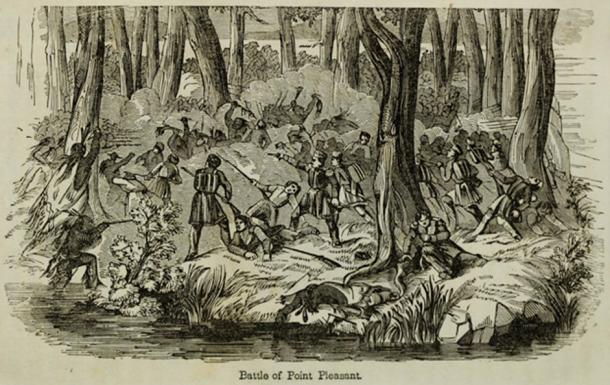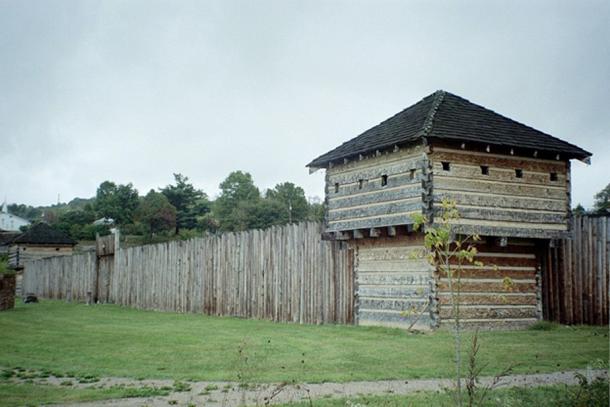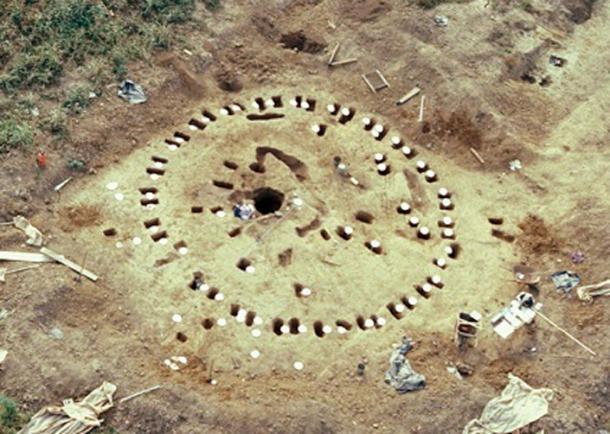
Burned Bones, Mysterious Timber Circles & the Rites of the Ancients – Adena Culture in Mason County, WV
Mason County, West Virginia is a place rich in history. Founded in 1804, the county is named after George Mason, who was a delegate at the American Constitutional Convention of 1787. In October of 1774, Colonel Andrew Lewis successfully lead the Virginia militia against a confederation of Algonquian Shawnee and Mingo forces led by Chief Cornstalk in the “Battle of Point Pleasant”. Lewis’ camp was named “camp Point Pleasant”, which became a permanent settlement and gradually grew into the modern town and County Seat of Mason County.

Illustration of Battle of Point Pleasant. 1854
Following the Battle of Point Pleasant, Chief Cornstalk ( Hokoleskwa or Kokolesqua in Shawnee) became a diplomat and peace advocate who secured working relations between his Shawnee kinsmen and Revolutionary Americans.

Illustration; one of the earliest depictions of Chief Cornstalk. (1720-1777) From Frost’s pictorial history of Indian wars and captivities from the earliest record of American history to the present time. 1872.


“How America Was Discovered is a story told by Handsome Lake (Seneca Prophet and contemporary of Cornstalk), and documented by Arthur C. Parker, about a young minister who meets the one he perceives to be the Lord, who then asks him to go to a new land and bring with him cards, money, a fiddle, whiskey, and blood corruption. In return the young minister will become rich. The young minister sought out Christopher Columbus, and with the help of his crew, traveled to the Americas. They turned back to report what they had seen, which caused an immigration of people from Europe to the Americas. Along with the people came the five things that aided in destroying the natives. The end reveals that the “Lord” in the gold castle was actually the devil, and that even he knew what he had caused was wrong.” Rudes, B. Tuscarora English Dictionary Toronto

Ganargua Creek (Mud Creek) was a primary stopover point for the Iroquois on their trade routes. Joseph Smith also had an interest in the creek after hearing a speech from Seneca Indian Chief Red Jacket at Palmyra in 1822. The Buffalo of Yesteryear: Red Jacket’s speech on religious freedom (left)
Disturbing Death and Injustice
In the fall of 1777, Cornstalk and his son, Elinipsico, were wrongly detained at Fort Randolph while attempting to engage in peaceful relations with the Virginia militia, and both were murdered on November 10th. By the time of his death, Chief Cornstalk had become a renowned figure throughout the American colonies, and there was outrage over his wrongful end.

None other than Patrick Henry (governor of Virginia at the time) attempted to bring justice upon Cornstalk’s killers, but the militiamen refused to testify against one another, and the murderers walked free.
While these historical events may be interesting enough in their own right, there are far older things buried in the ancient soil of Mason County. For over 2,000 years ago, this region of West Virginia hosted several ritual centers of the Adena Culture.
History Hidden in the Soil
The first to build burial mounds and earthworks in the Ohio River Valley, the chronology of the Adena Culture spans 1000 BC and to around 200 AD. A major Adena center (consisting of 10 earthen enclosures and between 40 and 50 burial mounds), was once located along the Kanawha River at the present-day location of Charleston, West Virginia in Kanawha County.
Another major conglomerate of Adena mounds once existed at Grave Creek Flats in Marshall County, consisting of several enclosures and around 47 mounds, including the famous Grave Creek Mound, which was originally between 60 and 65 feet in height. While these two locales have received the lion’s share of attention by historians and archaeologists in West Virginia, the lesser-known Adena sites in Mason County are extraordinary in their own right and provide a unique glimpse into Adena ritualism and burial practices.


Grave Creek Mound, Moundsville, West Virginia, USA (Tim Kiser
Ritual Circles
The Neibert Site was located along the Ohio River south of Point Pleasant, near the Gallipolis Locks and Dam. Excavations at Neibert ahead of a locks replacement project in the 1980s revealed the former existence of four or five timber circles located on a high terrace above the Ohio River.

Four of the circles were constructed in paired-post fashion, and all five were situated in a linear pattern variously 10-50 meters (32.8-164 feet) distant from one another.
Jason Jarrell and Sarah Farmer are investigative historians and avocational archaeologists. They study many subjects including depth psychology, Biblical mysteries, political science, and comparative mythology. They’re also authors of the book, Ages of the Giants: A Cultural History of the Tall Ones in Prehistoric America (2017).
Heartland Research with Wayne May and John Lefgren have been doing magnetometry research in Iowa near Nauvoo, Illinois for signs of ancient civilizations in the Heartland during Book of Mormon Times. They have found Adena Roundhouses like the one above. Visit my blog here to read more about it.





